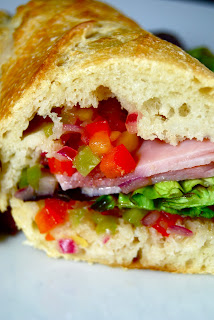"Cabrito" is another dish that Spaniards eat for Christmas or Easter. We used to eat it around Christmas when the owner of some goats would give us a goat as a present. My family had a piece of land with pine trees and we let him keep his goats there. His goats would eat the brush and this was great for us because then the land was clear. As a token of appreciation he would give us a live baby goat. This was a problem because as kids we would love the cute animal. I found goat meat in a Mexican store in town. They call it "chivo".
Ingredients:
2 1/2 pounds goat, cut in pieces
3 sprigs mint
2 sprigs rosemary
8 garlic cloves
2 sprigs thyme
salt and pepper to taste
2 large onions cut in julienne
3 large potatoes, cross cut
1/2 cup olive oil
1 large glass white wine
Chicken stock
In a blender mix the mint, rosemary, garlic, and salt and grind everything. Rub the goat pieces with the mixture from the blender and let it rest overnight inside a bag.
The next day, cut the onions and the potatoes. In a pan make a bed with the potatoes and then the onion. Add the wine and the olive oil, season with salt and pepper, and lay the goat over the onions and potatoes. Put uncovered in the oven at the highest temperature for 30 minutes and then lower to 350˚ until tender and the meat is falling from the bone. Once in a while, baste it to make sure that doesn't get dry, If that is the case, add chicken stock.
Ingredients:
2 1/2 pounds goat, cut in pieces
3 sprigs mint
2 sprigs rosemary
8 garlic cloves
2 sprigs thyme
salt and pepper to taste
2 large onions cut in julienne
3 large potatoes, cross cut
1/2 cup olive oil
1 large glass white wine
Chicken stock
In a blender mix the mint, rosemary, garlic, and salt and grind everything. Rub the goat pieces with the mixture from the blender and let it rest overnight inside a bag.
The next day, cut the onions and the potatoes. In a pan make a bed with the potatoes and then the onion. Add the wine and the olive oil, season with salt and pepper, and lay the goat over the onions and potatoes. Put uncovered in the oven at the highest temperature for 30 minutes and then lower to 350˚ until tender and the meat is falling from the bone. Once in a while, baste it to make sure that doesn't get dry, If that is the case, add chicken stock.

